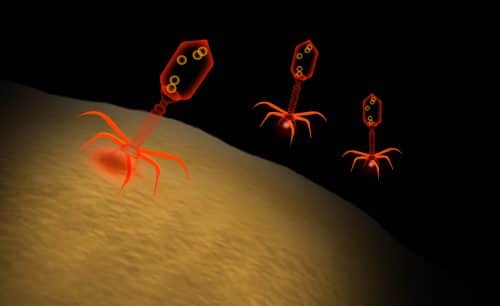Researchers from the Weizmann Institute discovered that viruses communicate among themselves based on messengers that are embedded in small molecules (peptides). By measuring the concentration of the peptide at the time of infection, the virus 'counts' how many previous viruses were able to infect "host" cells, and accordingly decides which strategy to take.

Viruses do secretly invade the body where they lodge, but it turns out that they actually have the opposite characteristic - "talkativeness". This is according to a new study by Weizmann Institute of Science scientists. This is the first time that it has been discovered that viruses communicate with each other, and that this is based on short messages. These messages help other viruses of the same type to decide how to proceed in the infection process: whether to multiply quickly, and thus eliminate the host cell, or - alternatively - go into a dormant state. the study Released Recently in the scientific journal Naturee.
"The dilemma, whether to continue multiplying or go into a dormant state, characterizes viruses such as AIDS and herpes, as well as viruses that attack bacteria (phages)," he explains Prof. Rotem Sorek from the Department of Molecular Genetics, who heads the research group. "However, until today it was not clear why the viruses prefer, in some cases, to enter a dormant state instead of acting immediately."
It became clear to the scientists that the viruses do not "fall asleep" and "wake up" at random, but maintain communication between them that they use to plan the attack. The "means of communication" is small molecules, which the viruses secrete into the environment, and in which the messages are stored. The interviral communication mechanism, the scientists say, was discovered almost by accident. "We assumed that bacteria infected by phages communicate with each other, and we looked for evidence of this," explains Prof. Sorek, "but we realized that the small molecules we discovered were secreted by the phages, not by the bacteria."

To find further evidence of this communication, the team grew bacteria in culture and infected them with phages. After filtering the substrate in which the culture grew, only the small molecules remained. "Then we grew additional bacteria in the filtered medium and infected them with phages," says Prof. Sorek. "And to our surprise we discovered that the new phages became dormant and did not kill the bacteria. We realized that this was due to the messages they received from the molecules that remained in the filtered substrate."
To confirm the nature of the molecules, the research leaders isolated them - research student Zohar Erez, staff scientist Dr. Gil Ameti, and Dr. Ida Steinberger-Levi from the Institute for Biological Research in Israel - and discovered that it was a short segment of protein, known as a peptide. Later, the scientists identified the gene encoding the peptide, and explained its mechanism of action. "We found that in the presence of high concentrations of the peptide, the phages choose a strategy of falling asleep," says Professor Sorek. "That's why we named the peptide, which is actually a small molecule, 'arbitrium', which means 'decision' in Latin."
The researchers discovered that every time a phage infects its host, it produces a little peptide and secretes it outside the cell. "Thus, by measuring the concentration of the peptide at the time of infection, the virus 'counts' how many previous viruses were able to infect 'host' cells, and accordingly decides which strategy to adopt," explains Prof. Sorek. "It makes sense that at the beginning of an infection, the viruses will want to multiply quickly. But if the viruses multiply more and more over time, then there will be no 'host' cells left for future generations of the virus. Therefore, at some point it is better for viruses to go into a dormant state, and stop killing the cells. It is the peptide that allows viruses to communicate with their future generations and deliver the message."

The team also revealed the mechanism of action that enables the activation and cancellation of the "dormant state". They discovered that the peptide paralyzes a certain protein of the virus, whose function is to block the dormant state, and thus the blockage is removed and the dormant state is activated.
After identifying the mechanism in one type of phage, the scientists were able to identify similar molecules in dozens of other phages from the same family. They found that each such phage produced a slightly different peptide. "We were able to locate a specific communication code for each phage," says Prof. Sorek. "It's as if each phage transmits on a certain communication 'frequency', which can only be received by phages of the same species."
The inter-viral communication strategy identified by the group, Prof. Sorek emphasizes, may have broad implications: "We discovered a new pattern in the theory of viruses. It is possible that non-phage viruses that infect our bodies use a strategy similar to that used by phages to transmit messages. If this is indeed the case, we may be able to learn to decode these messages, and use them to block the rapid multiplication of viruses in our body cells."

One response
Amazing. Possibility of developing new drugs soon! For diseases like influenza, the peptide is given as a medicine, the viruses fall asleep. When you stop the medicine (perhaps gradually) the body has already developed a vaccine. For diseases like AIDS, the peptide is given for life.